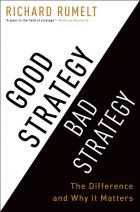It looks to me as if there is really only one question you are asking in each case. The question is: ‘what is really going on here?’ ”
The remark was made by a colleague of Richard Rumelt at the Anderson School of Management at UCLA, who had sat through several of Prof Rumelt’s strategy classes.
Prof Rumelt, described by the McKinsey Quarterly as “the strategist’s strategist”, is not the publicity-seeking guru routinely heard on the conference circuit. He is author of two books, with an interval of 37 years between them. The more recent, Good Strategy/Bad Strategy, was the most interesting business book of 2011.
The comment of Prof Rumelt’s colleague appears banal but gets to the heart of the matter. I long ago realised that to understand a business I would learn much more by talking to people involved in day-to-day operations than the chief executive. They represented “what is really going on here?”.
The message of Prof Rumelt’s book is that strategy is really just careful thinking about business problems. Checklists – Swot (strengths, weaknesses/limitations, opportunities, threats), five forces or seven Ss – are popular because they are a starting point for people who are unaccustomed to structured thought. Good strategy begins with diagnosis. And diagnosis is analysis, not a description of symptoms. You don’t go to your doctor to be told you have a sore throat. You go to be told you have an infection and that an antibiotic will fix it. The doctor tries to discover “what is really going on here?” and the measure of his competence is his ability to do that.
If that also sounds obvious, it isn’t what business people typically do. In the business world – as sometimes in the surgery – the reputation of the CEO or value of the consultant is measured not by the accuracy of the diagnosis but by the confidence with which the prescription is dispensed. Many business gurus resemble George Bernard Shaw’s doctor, Sir Colenso Ridgeon, who treated every ailment with an exhortation to “stimulate the phagocytes”. Their PowerPoint presentations reiterate the patient’s complaint and prescribe their universal template.
Diagnosis is analysis, not a description of symptoms. You don’t go to your doctor to be told you have a sore throat
The starting point of bad strategy is often a goal – a 20 per cent share of the European widget market, with a 15 per cent return on equity. The bad strategist confuses policy – to become Europe’s leading widget maker through complementary acquisitions – with strategy. Bad strategy is often fluff – to become the widget provider of choice by exceeding customer expectations.
Declining market share or inadequate profitability is not the problem, but the symptom of the problem. But in business, as in the surgery, such diagnosis is frequently uncomfortable and embarrassing. And self-examination demands honesty which is particularly difficult to achieve in groups of competitive individuals. It is easier to announce aspirations, or to luxuriate in fluff. Then you seek “buy-in” to your bad strategy. That process saves thought and minimises disagreement.
For Prof Rumelt, the kernel of a strategy is the diagnoses of a situation, the choice of an overall guiding policy and the design of coherent action. A guiding policy is an element of strategy, but is not a strategy until it is translated into specific actions. One of the silliest remarks in business is “strategy is easy, implementation is difficult”. But strategy that lacks a clear path to implementation is not strategy at all, just wishful thinking.
As it was for Chad Logan, the hero of one of Prof Rumelt’s many delicious vignettes, whose strategy was 20/20: 20 per cent growth and 20 per cent margins accompanied by the mantra that you can achieve anything if you want it enough. The same magical thinking served Joseph Silver, the investment banker who proclaimed the virtues of economies of mass. Dr Ridgeon is alive and well – and ensconced at Morgan Stanley. Read Good Strategy/Bad Strategy for the entertaining experiences of a man who has spent 40 years in the strategy business. But read it principally for its profound yet common sense approach to business.

